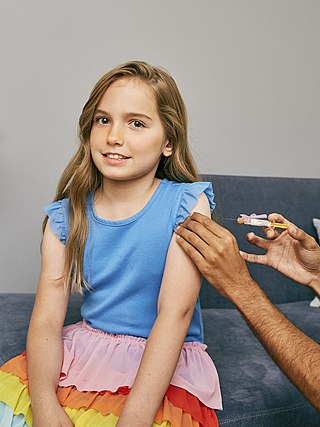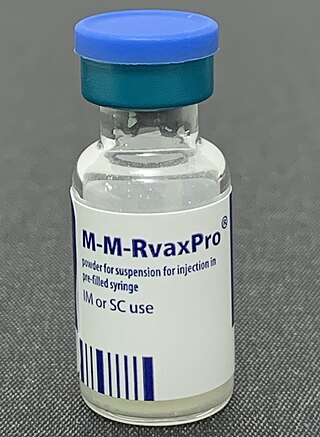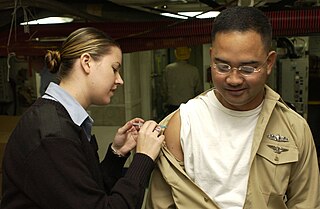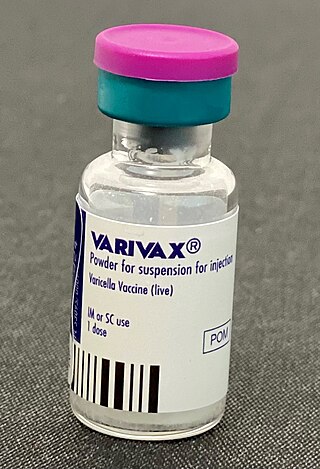Related Research Articles

Vaccination is the administration of a vaccine to help the immune system develop immunity from a disease. Vaccines contain a microorganism or virus in a weakened, live or killed state, or proteins or toxins from the organism. In stimulating the body's adaptive immunity, they help prevent sickness from an infectious disease. When a sufficiently large percentage of a population has been vaccinated, herd immunity results. Herd immunity protects those who may be immunocompromised and cannot get a vaccine because even a weakened version would harm them. The effectiveness of vaccination has been widely studied and verified. Vaccination is the most effective method of preventing infectious diseases; widespread immunity due to vaccination is largely responsible for the worldwide eradication of smallpox and the elimination of diseases such as polio and tetanus from much of the world. However, some diseases, such as measles outbreaks in America, have seen rising cases due to relatively low vaccination rates in the 2010s – attributed, in part, to vaccine hesitancy. According to the World Health Organization, vaccination prevents 3.5–5 million deaths per year.

A vaccine is a biological preparation that provides active acquired immunity to a particular infectious or malignant disease. The safety and effectiveness of vaccines has been widely studied and verified. A vaccine typically contains an agent that resembles a disease-causing microorganism and is often made from weakened or killed forms of the microbe, its toxins, or one of its surface proteins. The agent stimulates the body's immune system to recognize the agent as a threat, destroy it, and recognize further and destroy any of the microorganisms associated with that agent that it may encounter in the future.

The Mantoux test or Mendel–Mantoux test is a tool for screening for tuberculosis (TB) and for tuberculosis diagnosis. It is one of the major tuberculin skin tests used around the world, largely replacing multiple-puncture tests such as the tine test. The Heaf test, a form of tine test, was used until 2005 in the UK, when it was replaced by the Mantoux test. The Mantoux test is endorsed by the American Thoracic Society and Centers for Disease Control and Prevention. It was also used in the USSR and is now prevalent in most of the post-Soviet states, although Soviet mantoux produced many false positives due to children's allergic reaction.

The MMR vaccine is a vaccine against measles, mumps, and rubella, abbreviated as MMR. The first dose is generally given to children around 9 months to 15 months of age, with a second dose at 15 months to 6 years of age, with at least four weeks between the doses. After two doses, 97% of people are protected against measles, 88% against mumps, and at least 97% against rubella. The vaccine is also recommended for those who do not have evidence of immunity, those with well-controlled HIV/AIDS, and within 72 hours of exposure to measles among those who are incompletely immunized. It is given by injection.

The DPT vaccine or DTP vaccine is a class of combination vaccines to protect against three infectious diseases in humans: diphtheria, pertussis, and tetanus (lockjaw). The vaccine components include diphtheria and tetanus toxoids, and either killed whole cells of the bacterium that causes pertussis or pertussis antigens. The term toxoid refers to vaccines which use an inactivated toxin produced by the pathogen which they are targeted against to generate an immune response. In this way, the toxoid vaccine generates an immune response which is targeted against the toxin which is produced by the pathogen and causes disease, rather than a vaccine which is targeted against the pathogen itself. The whole cells or antigens will be depicted as either "DTwP" or "DTaP", where the lower-case "w" indicates whole-cell inactivated pertussis and the lower-case "a" stands for "acellular". In comparison to alternative vaccine types, such as live attenuated vaccines, the DTP vaccine does not contain any live pathogen, but rather uses inactivated toxoid to generate an immune response; therefore, there is not a risk of use in populations that are immune compromised since there is not any known risk of causing the disease itself. As a result, the DTP vaccine is considered a safe vaccine to use in anyone and it generates a much more targeted immune response specific for the pathogen of interest.

Feline leukemia virus (FeLV) is a retrovirus that infects cats. FeLV can be transmitted from infected cats when the transfer of saliva or nasal secretions is involved. If not defeated by the animal's immune system, the virus weakens the cat's immune system, which can lead to diseases which can be lethal. Because FeLV is cat-to-cat contagious, FeLV+ cats should only live with other FeLV+ cats.

Influenza vaccines, colloquially known as flu shots or the flu jab, are vaccines that protect against infection by influenza viruses. New versions of the vaccines are developed twice a year, as the influenza virus rapidly changes. While their effectiveness varies from year to year, most provide modest to high protection against influenza. Vaccination against influenza began in the 1930s, with large-scale availability in the United States beginning in 1945.

Carnivore protoparvovirus 1 is a species of parvovirus that infects carnivorans. It causes a highly contagious disease in both dogs and cats separately. The disease is generally divided into two major genogroups: FPV containing the classical feline panleukopenia virus (FPLV), and CPV-2 containing the canine parvovirus type 2 (CPV-2) which appeared in the 1970s.

Canine parvovirus is a contagious virus mainly affecting dogs and wolves. CPV is highly contagious and is spread from dog to dog by direct or indirect contact with their feces. Vaccines can prevent this infection, but mortality can reach 91% in untreated cases. Treatment often involves veterinary hospitalization. Canine parvovirus often infects other mammals including foxes, wolves, cats, and skunks. Felines (cats) are also susceptible to panleukopenia, a different strain of parvovirus.

Feline calicivirus (FCV) is a virus of the family Caliciviridae that causes disease in cats. It is one of the two important viral causes of respiratory infection in cats, the other being Felid alphaherpesvirus 1. FCV can be isolated from about 50% of cats with upper respiratory infections. Cheetahs are the other species of the family Felidae known to become infected naturally.
A vaccine-associated sarcoma (VAS) or feline injection-site sarcoma (FISS) is a type of malignant tumor found in cats which has been linked to certain vaccines. VAS has become a concern for veterinarians and cat owners alike and has resulted in changes in recommended vaccine protocols. These sarcomas have been most commonly associated with rabies and feline leukemia virus vaccines, but other vaccines and injected medications have also been implicated.

Vaccination of dogs is the practice of animal vaccination applied to dogs. Programs in this field have contributed both to the health of dogs and to the public health. In countries where routine rabies vaccination of dogs is practiced, for example, rabies in humans is reduced to a very rare event.

Varicella vaccine, also known as chickenpox vaccine, is a vaccine that protects against chickenpox. One dose of vaccine prevents 95% of moderate disease and 100% of severe disease. Two doses of vaccine are more effective than one. If given to those who are not immune within five days of exposure to chickenpox it prevents most cases of disease. Vaccinating a large portion of the population also protects those who are not vaccinated. It is given by injection just under the skin. Another vaccine, known as zoster vaccine, is used to prevent diseases caused by the same virus – the varicella zoster virus.

Hepatitis B vaccine is a vaccine that prevents hepatitis B. The first dose is recommended within 24 hours of birth with either two or three more doses given after that. This includes those with poor immune function such as from HIV/AIDS and those born premature. It is also recommended that health-care workers be vaccinated. In healthy people, routine immunization results in more than 95% of people being protected.

The health of domestic cats is a well studied area in veterinary medicine.

Yellow fever vaccine is a vaccine that protects against yellow fever. Yellow fever is a viral infection that occurs in Africa and South America. Most people begin to develop immunity within ten days of vaccination and 99% are protected within one month, and this appears to be lifelong. The vaccine can be used to control outbreaks of disease. It is given either by injection into a muscle or just under the skin.
A subunit vaccine is a vaccine that contains purified parts of the pathogen that are antigenic, or necessary to elicit a protective immune response. Subunit vaccine can be made from dissembled viral particles in cell culture or recombinant DNA expression, in which case it is a recombinant subunit vaccine.
Vaccinia immune globulin (VIG) is made from the pooled blood of individuals who have been inoculated with the smallpox vaccine. The antibodies these individuals developed in response to the smallpox vaccine are removed and purified. This results in VIG. It can be administered intravenously. It is used to treat individuals who have developed progressive vaccinia after smallpox vaccination.

Animal vaccination is the immunisation of a domestic, livestock or wild animal. The practice is connected to veterinary medicine. The first animal vaccine invented was for chicken cholera in 1879 by Louis Pasteur. The production of such vaccines encounter issues in relation to the economic difficulties of individuals, the government and companies. Regulation of animal vaccinations is less compared to the regulations of human vaccinations. Vaccines are categorised into conventional and next generation vaccines. Animal vaccines have been found to be the most cost effective and sustainable methods of controlling infectious veterinary diseases. In 2017, the veterinary vaccine industry was valued at US$7 billion and it is predicted to reach US$9 billion in 2024.
Autogenous vaccines, also called autologous vaccines, autovaccines, “self” or custom vaccines, are vaccines that are prepared by isolation and destruction of microorganisms in infected individuals and used to provide immunity to the same individual.
References
- 1 2 "Efficacy and effectiveness". Immunisation Advisory Centre. July 26, 2016. Archived from the original on June 15, 2017. Retrieved November 14, 2019.
- 1 2 3 Day, M. J.; Horzinek, M. C.; Schultz, R. D.; Squires, R. A. (2016). "WSAVA Guidelines for the vaccination of dogs and cats". Journal of Small Animal Practice. 57 (1): E1–E45. doi: 10.1111/jsap.2_12431 . ISSN 1748-5827. PMC 7166872 . PMID 26780857.
- ↑ "Feline Vaccination Advisory Panel Report | American Association of Feline Practitioners". catvets.com. Archived from the original on 2019-10-02. Retrieved 2019-03-16.
- ↑ "Vaccines and vaccination – an introduction |". 5 January 2008. Retrieved 2019-03-16.
- ↑ "Vaccination for animal health: an overview". NOAH (National Office of Animal Health). Retrieved 2019-03-16.
- 1 2 "CVMA | Documents | Vaccination and Your Cat". www.canadianveterinarians.net. Archived from the original on 2020-07-31. Retrieved 2019-03-16.
- 1 2 3 "Vaccinations for Your Cat". 2013.